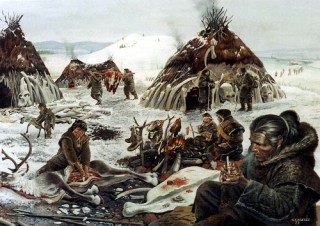I just came across this article [1] and found that it’s really quite interesting. It’s about why we are insulin resistant. Even though the term «insulin resistance» is mostly used to describe a pathological condition, all tissues that can respond to insulin are, to some extent, insulin resistant and so we are all displaying various degrees of insulin resistance in various tissues all the time. Insulin resistance is simply when a tissue do not respond to insulin or responds poorly. So when muscles, for example, become insulin resistant, they do not take up as much glucose from the blood despite high blood insulin level. And they will keep burning a larger proportion of fat despite insulin trying to make them burn sugar.
«Certain metabolic adaptations were necessary to accommodate low carbohydrate intake because the brain and reproductive tissues had evolved a specific requirement for glucose as a source of fuel.»
«The amount of carbohydrate may have ranged from as little as 10 g up to 125 g a day, much lower than the typical 250 to 400 g per day consumed in modern diets.«
Brand-Miller, Griffin and Colagiuri looks at insulin resistance from an evolutionary perspective. The basis for the article is that the last 2 million years of human evolution was dominated by a low carbohydrate intake. This may have caused a selective pressure for insulin resistance. In addition, environmental pressures such as geographic isolation and/or starvation may have further increased the prevalence of insulin resistance genes in certain populations. The reason is that when carbohydrate intake is low it is important that the tissues that do not need to burn glucose and can burn fat become insulin resistant, thus freeing glucose for the tissues that need glucose and cannot burn fat.
«With the first severe Ice Age, global temperatures fell dramatically and resulted in moist African forest becoming dry, open woodland and savannah. Hominids that were unable to utilize grasslands became increasingly carnivorous.»
«In Africa and Eurasia, hunted animals displaced gathered plant foods as the principal source of food, leading to a diet low in carbohydrate and high in protein for most of the year. Increased meat intake from wild terrestrial and marine animals would have also provided greater amounts of omega-3 fatty acids such as docosahexaenoic acid essential for brain development, facilitating the larger brain size of H. sapien.»
The authors further hypothesize that the selective pressure for insulin resistance was relaxed with the advent of agriculture and the increasing amounts of carbohydrate in the human diet. Domestication of cereal grains first began in the Middle east, some 12 000 years ago, and spread across to Europe and East Asia. The logic thus goes that populations that only recently have adopted agriculture are more likely to become insulin resistant, overweight and at ill health than those populations longer exposed.
As examples of such cultures the authors mention the Pima Indians, Nauruans, and Australian Aboriginals. The Pima only adopted agriculture some 5000 years ago, about the same time as us Norwegians.
According to the authors the carnivore connection hypothesis hinges on five lines of evidence:
(1) During the last two million years of evolution, humans were increasingly carnivorous, that is, consumed a low-carbohydrate, high-protein diet.
(2) A low-carbohydrate, high-protein diet requires profound insulin resistance to maintain glucose homeostasis, particularly during reproduction.
(3) Genetic differences in insulin resistance and predisposition to type 2 diabetes can be explained by differences in exposure to carbohydrate during the past 12,000 years.
(4) Changes in the quality of carbohydrate can explain the higher prevalence of type 2 diabetes in susceptible populations.
(5) Habitual consumption of a high-glycemic-load diet worsens insulin resistance and contributes to the obesity and type 2 diabetes in all populations.
 |
| Food |
«We propose that the selection pressure for insulin resistance was relaxed first in Europeans when dietary carbohydrate increased 12,000 years ago with the advent of agriculture. In accordance with this long-term exposure, Europeans have experienced a lower prevalence of diabetes, even when overweight and obese (see Section 6), compared to other population groups.»
One aspect of this article I particularly liked, was that they did not adhere to a common misconception of food availability. They mention Neel’s thrifty gene hypothesis which suggests that cycles of «feast and famine selected for a quick insulin trigger.» They also mention Gerald Raven’s similar hypothesis that suggests that «muscle insulin resistance was the key to survival during food scarcity because it conserved glucose by minimizing gluconeogenesis and preserving lean body mass.» Both of these hypotheses are based on an assumption that food must have been hard to come by during our recent evolution. To me this is a serious underestimation of humans and suggests that those doing the hypothesizing have themselves not spent much time outdoors. Luckily, Brand- Miller and coworkers are aware of the shortcomings of these hypotheses and write: «However, this is not supported by the scientific literature. While hunter gatherers would have been exposed to seasonal and geographical changes in food supply, severe food shortages or starvation were rare and more likely to occur after the transition to agriculture (preindustrialization).»
The authors also spend some time discussing types of carbohydrate and the transition from complex unrefined to refined easily digestible and the concomitant change in glycemic index. This might have further enhanced the insulin resistance promoting effects of our high carbohydrate diet.
Humans are well adapted low carbohydrate intakes, but it seems this ability might have come at a cost. Anyway, it seems many of us are fighting our genetic disposition by stuffing ourselves with carbohydrates. All in all a really interesting article and well worth a read.
1. Brand-Miller JC, Griffin HJ, Colagiuri S: The carnivore connection hypothesis: revisited. J Obes 2012, 2012: 258624.

Legg igjen en kommentar